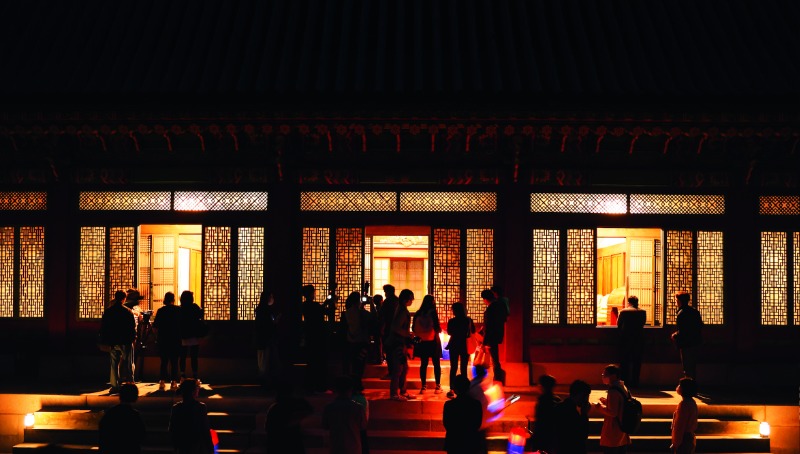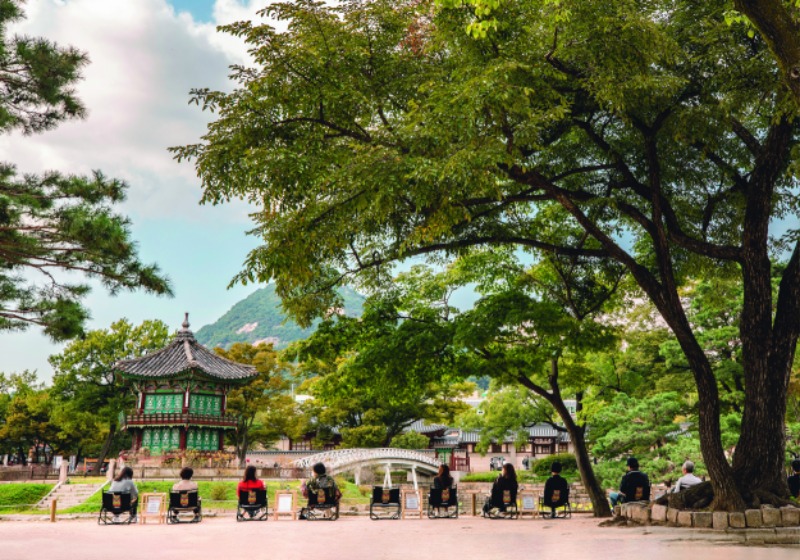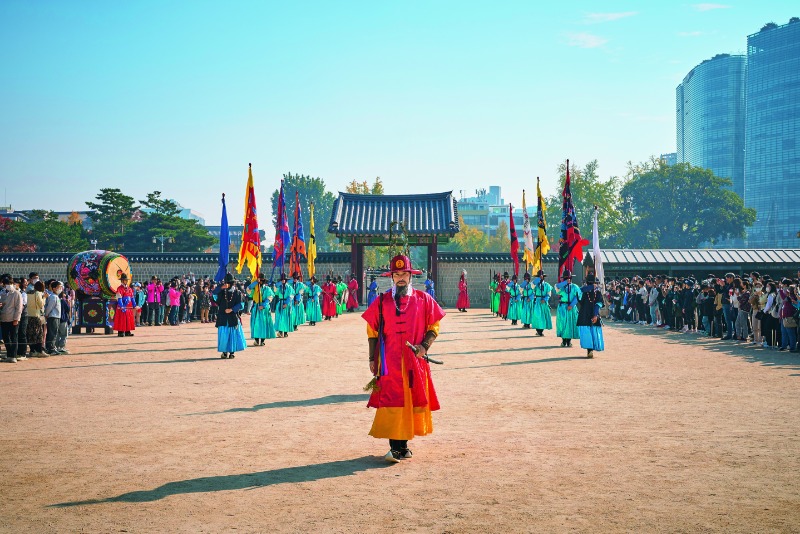Korean palaces are not simply historical structures. They are revitalized spaces with wildly popular programs that give visitors a chance to experience distinctive elements of traditional culture that are absent in current pop culture.

Participants of the “Changdeok Palace Moonlight Tour” peer into the interior of Daejojeon, the queen’s chambers. The Cultural Heritage Administration and the Korean Cultural Heritage Foundation began the evening palace tour in 2010. Today, it is as popular as ever, offering visitors a chance to explore areas normally closed to the public.
© Joongang Ilbo
All the bustling visitors are gone. The gates are shut. Time stops in the palace as darkness shrouds the stately buildings, picturesque pavilions, beautiful gardens, and open spaces. But on appointed days, some palaces reopen for evening programs that are markedly different from daytime visits.
Although movement around some areas is more controlled, docents are available to share their vast knowledge, and nocturnal visitors are treated to musical performances and cuisine — dishes that were enjoyed by the royal household.
The most notable night-tour programs are held at Changdeok Palace, Gyeongbok Palace, and Deoksu Palace. While the “Changdeok Palace Moonlight Tour” is conducted entirely outdoors and has the least spatial constraints, the highlight of the “Gyeongbok Palace Starlight Tour” is a dinner inside the palace quarters. “Seokjojeon at Night,” held at Deoksu Palace, is arguably the most popular program on the night tour circuit, as it includes a taste of Emperor Gojong’s favorite dessert as well as a classical music performance.
Tickets for these night tours, costing between 26,000 and 60,000 won, are coveted, with less than 14,000 sold annually. Whenever the Korean Cultural Heritage Foundation opens its reservation website, tickets sell out in one or two minutes. The frenzy, called gungketing, a portmanteau of gung (palace) and ticketing, is led by young adults. With their interest and enthusiasm pumped up by social media posts and pictures, teenagers and adults under 30 account for 80 percent of the experience seekers. Many later rejoin the scramble for tickets, hoping to relive their unforgettable evening palace experience.
Under the Moonlight
The “Changdeok Palace Moonlight Tour” is the steadiest seller among all palace-related activities. Launched in 2010, it initially involved a walk in the palace’s rear garden. It was held five days a month, around the time of the full moon. However, overwhelming popularity from the very beginning led to an increase in frequency. It now attracts the largest number of annual visitors, with up to 9,000 people paying the 30,000 won for a ticket.
These days, the event is open for about 70 days a year in the spring and autumn, when the palace is most beautiful. It starts around 7 p.m., an hour after the palace’s normal closing time. The main gate of the palace, Donhwamun, is opened, and six groups of 25 visitors each are admitted at staggered intervals.
The 100-minute program starts with a tour and ends with a musical performance. The guided tour is designed to explore about ten buildings in and around the rear garden, the most attractive part of Changdeok Palace. This tour allows guided groups to see places that are usually inaccessible to the general public at night. They can also take photos with actors dressed as the king and queen of the Joseon Dynasty and enjoy traditional music played with traditional instruments such as the daegeum (bamboo flute), geomungo, and ajaeng (zithers).
At Yeongyeongdang, a tranquil residence inside the rear garden, visitors are seated where performances were held during the Joseon Dynasty. They are treated to traditional tea and cookies while watching a concert consisting of court dances, singing, and instrumental music.
Luxury at Night
The “Starlight Tour at Gyeongbok Palace” started in 2016. It runs for 40 days in the spring and autumn, with two daily tours, each open to a maximum of 32 people. That allows for a yearly audience of only 2,560 visitors.
The highlight of the tour is a meal inside the palace while being entertained. Thus, the ticket prices are the highest — 50,000 to 60,000 won, depending on the menu. The meal is served at Oesojubang, the outer kitchen where royal banquets were prepared during the Joseon Dynasty.
The food, served in four-tiered brass lunchboxes, comes from Korea House, a restaurant in Seoul that specializes in court cuisine. With only 2,560 tickets available per year, the tour is a rare opportunity to sit in one of the palace buildings before a royal dinner table and enjoy traditional music performances. After the meal, visitors can explore the northern part of the king’s residential quarters for about one hour.
Deoksu Palace, completed in 1910, was an imperial residence during the Korean Empire (1897–1910). It boasts a unique blend of traditional Korean and Western architecture, including Seokjojeon, a Western-style building made of stone.
Despite only joining the evening palace tours in 2021, Deoksu Palace’s “Seokjojeon at Night” quickly became as prized as other palace events, with tickets going for 26,000 won. Seokjojeon is open to the public during the daytime, but being inside it at night is a special experience.
Like other nighttime tours, “Seokjojeon at Night” is held in the spring and autumn. With 16 visitors per session and three sessions per day for 48 days, slightly more than 2,300 tickets are sold annually. The program includes a guided tour of the building, followed by a coffee break while enjoying classical music on the terrace of the second floor. Visitors can also enjoy songs from popular musicals set against the backdrop of the Korean Empire. The terrace offers a stunning view of Seoul’s cityscape, making it a perfect spot for memorable photographs.
Changing of the Guard

Simkung Shimgung, a program organized by the Korean Cultural Heritage Foundation, is designed to make Gyeongbok Palace a place for relaxation, healing, and reflection. It includes meditation and aromatherapy at the Hyangwonjeong, a pavilion at the center of a square-shaped pond.
© Korean Cultural Heritage Foundation
If palace tours are the charm of the night, the spectacle of the daytime is the royal guard changing ceremony at Gyeongbok Palace. This event was initiated to exhibit Korean heritage during the 2002 Korea–Japan World Cup. During the Joseon Dynasty, the gatekeepers were responsible for opening and closing the palace gates and safeguarding the royal residence.
To choreograph the reenactment, experts in various subjects such as rituals, ceremonial ornaments, and palace uniforms pored over historical s and materials, repeatedly verifying artifacts to ensure the highest accuracy. The result was the reenactment of the palace guard changeover ceremony. Even today, the event continues to be fine-tuned as new research findings are announced or artifacts are discovered. The ceremony is held every day except Tuesdays, when the palace is closed. The palace guard has about one hundred soldiers. They include members of the military band who play chwita, a type of military processional music featuring wind and percussion instruments.
Visitors can watch the soldiers’ training sessions every day at 9:35 a.m. and 1:35 p.m., before the changeover ceremony is conducted at 10 a.m. and 2 p.m. No reservations are needed. The guards are also available to take photos with visitors.

The royal guard changing ceremony at Gyeongbok Palace, which began in 2002, gives viewers a glimpse into how the center of governance was safeguarded during the Joseon Dynasty.
© Korean Cultural Heritage Foundation
Other events staged at the palaces include the “Royal Music Performance,” which combines traditional and modern genres in a fusion of court music and ballet; the “Changgyeong Palace Yayeon,” a recreation of palace entertainment at banquets hosted by the king for senior officials; and the “K-Royal Culture Festival,” a celebration of the arts. These events fill the old palaces with energy, turning them into stages for concerts, exhibitions, and ritual reenactments instead of leaving them as sites in the pages of history.